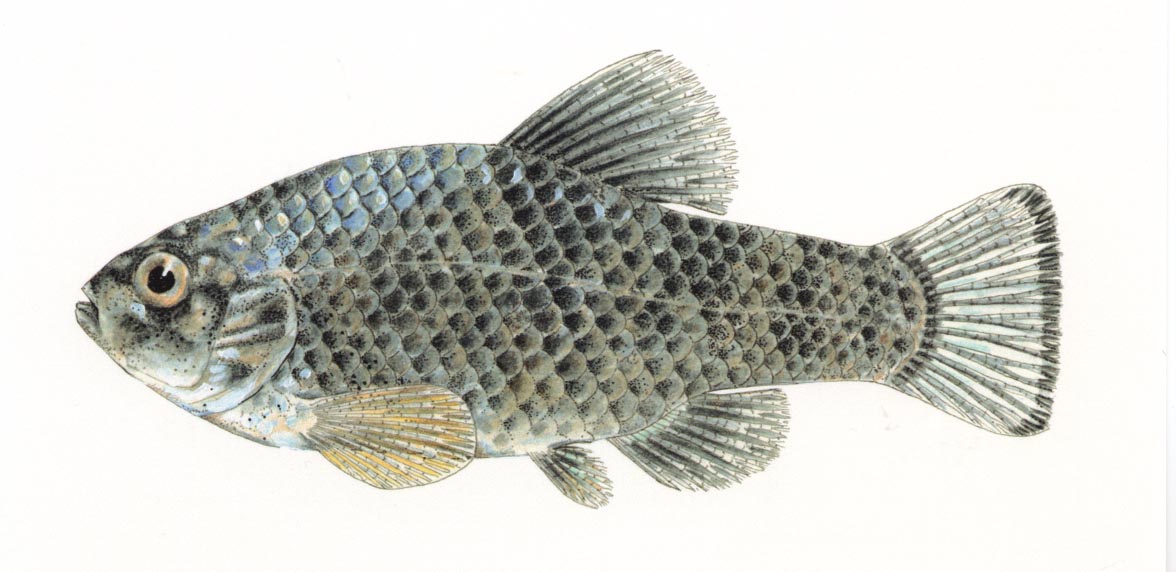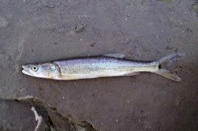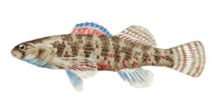Current Research by Division of Fishes Personnel
Breeding Behaviors of Bonytail Chub
Megan Osborne is currently leading a project centered on rearing endangered fish (bonytail chub) in off-channel habitats where they were somewhat protected from predation yet are subjected to the natural environment and selective pressures. In off-channel habitats individuals mate freely but there may be high variance in reproductive success; reducing genetic diversity. For this reason it is imperative that adults and their progeny are genetically monitored to assess parental contributions. This project will provide crucial information on the breeding behavior of bonytail chub and will allow assessment of how variance in reproductive success affects genetic diversity and genetic effective size.
Conservation of Two San Juan River Fish
Nathan Franssen, a postdoctoral research associate in the Department of Biology, primarily addresses the conservation of Colorado pikeminnow (Ptychocheilus lucius) and razorback sucker (Xyrauchen texanus) of the San Juan River of New Mexico and Utah. He is working with personnel at the U.S. Fish and Wildlife Service and New Mexico Department of Game and Fish to test hypotheses about factors limiting the persistence of these threatened fishes using long-term monitoring data. Specifically, his research addresses how native and nonnative fish interactions, annual variation in flow and temperature regimes, mechanical removal of nonnative fishes, and alteration to stream habitats are affecting population dynamics of native and nonnative fishes.
Conservation and Management of Freshwater Fishes
Michael Schwemm's research focus principally applies population genetic tools towards the conservation and management of freshwater fishes. His work seeks to interpret patterns of genetic variation in natural and reintroduced populations, and spans the disciplines of historical biogeography, life-history ecology, conservation genetics and fisheries management. Much of his work involves collaboration with state, federal and nongovernmental agencies of the middle and southwestern US.
Recent Publications by Division of Fishes Personnel
Ross, S. T. and W. J. Matthews. 2014. Chapter 1. Evolution and ecology of North American freshwater fish assemblages. In: North American Freshwater Fishes: Ecology, Evolution, and Behavior. M. L. Warren, Jr. and B. M. Burr (eds.). Johns Hopkins University Press.
Ross, S. T. 2013. Ecology of North American Freshwater Fishes. University of California Press, Berkeley. 486 pp. ISBN 978-0-520-24945-5
Carson, E. W., H. Espinosa-Pérez, and V. Souza. 2013. Low mitochondrial DNA sequence variation in the microendemic Cuatro Ciénegas Platyfish Xiphophorus gordoni. Western North American Naturalist 73:224-229.
Carson, E. W., R. R. Beasley, K. L. Jones, S. L. Lance, M. de L. Lozano-Vilano, L. Vela-Valladares, I. Banda-Villanueva, T. F. Turner, and M. De la Maza-Benignos. 2013. Development of polymorphic microsatellite markers for the microendemic pupfishes Cyprinodon julimes and C. pachycephalus. Conservation Genetics Resources. 5:853-856.
Carson, E. W., M. De la Maza-Benignos, Ma. de L. Lozano-Vilano, L. Vela-Valladares, I. Banda-Villanueva, and T. F. Turner. Early View. Conservation genetic assessment of the critically endangered Julimes Pupfish, Cyprinodon julimes. Conservation Genetics. DOI:10.1007/s10592-013-0548-x.
Dowling, T. E., T. F. Turner, E. W. Carson, M. J. Saltzgiver, D. Adams, B. Kesner, and P. C. Marsh. Early View. Time-series analysis reveals genetic responses to intensive management of Razorback Sucker (Xyrauchen texanus). Evolutionary Applications. DOI:10.1111/eva.12125
Franssen, N.R., J.E. Davis, D. Ryden and K.B. Gido. 2014. Fish community responses to mechanical removal of nonnative fishes in a large southwestern river. Fisheries 39:352–363.
Franssen, N.R., C.G. Goodchild, and D.B. Shepard. 2014. Morphology predicting ecology: incorporating new methodological and analytical approaches. Environmental Biology of Fishes. 10.1007/s10641-014-0306-z
Zamor, R.M., N.R. Franssen, C. Porter, T.M. Patton, and K.D. Hambright. 2014. Rapid recovery of a fish assemblage following an ecosystem disruptive algal bloom. Freshwater Science. 33:390–401.
Durst, S.L. and N.R. Franssen. 2014. Movement and growth of juvenile Colorado pikeminnows (Ptychocheilus lucius) in the San Juan River, NM and UT. Transactions of the American Fisheries Society 143:519–527.
Franssen, N.R., L.K. Stewart, and J.F. Schaefer. 2013. Morphological divergence and flow-induced phenotypic plasticity in a native fish from anthropogenically altered stream habitats. Ecology and Evolution 3: 4648–4657.
Marsh-Matthews, E., J. Thompson, W.J. Matthews, A. Geheber, N.R. Franssen, and J. Barkstedt. 2013. Differential survival of two minnow species under experimental sunfish predation: implications for re-invasion of a species back into its native range. Freshwater Biology 58:1745–1754.
Franssen, N.R. and M. Tobler. 2013. Upstream effects of a reservoir on fish assemblages 45 years following impoundment. Journal of Fish Biology 82:1659–1670.
Franssen, N.R., L.K. Stewart, and J.F. Schaefer. 2013. Morphological divergence and flow-induced phenotypic plasticity in a native fish from anthropogenically altered stream habitats. Ecology and Evolution. DOI: 10.1002/ece3.842.
Franssen, N.R. and S.L. Durst. 2013. Prey and nonnative fish predict the distribution of Colorado Pikeminnow (Ptychocheilus lucius) in a south-western river in North America. Ecology of Freshwater Fish. DOI: 10.1111/eff.12093.
Franssen, N.R. and M. Tobler. 2013. Upstream effects of a reservoir on fish assemblages 45 years following impoundment. Journal of Fish Biology 82:1659–1670.
Franssen, N.R., J. Harris, S.R. Clark, J.F. Schaefer, and L.K. Stewart. 2013. Shared and unique morphological responses of stream fishes to anthropogenic habitat alteration. Proceedings of the Royal Society B. 280: 20122715.
Gido, K.B., D.L. Propst, J.D. Olden, and K.R. Bestgen. 2013. Multidecadal responses of native and introduced fishes to natural and altered flow regimes in the American Southwest. Canadian Journal of Fisheries and Aquatic Sciences. 70: 554-564. dx.doi.org/10.1139/cjfas-2012-0441.
Hanna, A. H., K. W. Conway, E. W. Carson, G. P. Garrett, and J. R. Gold. 2013. Conservation genetics of an undescribed species of Dionda (Teleostei: Cyprinidae) in the Rio Grande drainage in western Texas. Southwestern Naturalist. 58:35-40.
Hoagstrom, C. W. and T. F. Turner. 2013. Recruitment ecology of pelagic-broadcast spawning minnows: paradigms from the ocean advance science and conservation of an imperiled freshwater fauna. Fish and Fisheries. Online Early. DOI: 10.1111/faf.12054
Marsh-Matthews, E., J. Thompson, W.J. Matthews, A. Geheber, N.R. Franssen, and J. Barkstedt. 2013. Differential survival of two minnow species under experimental sunfish predation: implications for re-invasion of a species back into its native range. Freshwater Biology. 58:1745–1754.
Osborne, M.J., Perez, T., Altenbach, C.S. and T.F. Turner (2013) Genetic analysis of captive spawning strategies for the endangered Rio Grande Silvery Minnow (Hybognathus amarus). Journal of Heredity. 104 (3): 437-446.
Osborne, M.J., Diver, T.A., and T.F. Turner (2013) Introduced populations as genetic reservoirs for imperiled species: a case study of the Arkansas River Shiner (Notropis girardi). Conservation Genetics. 14(3): 637-647.





